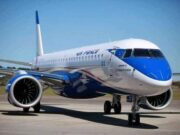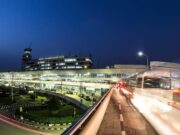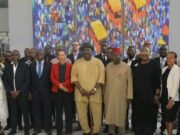…Protests Fee, Cites Economic Impact
There is tension between the Ministry of Aviation and Aerospace Development and helicopter operators in the country due to a $300 landing levy imposed on operators.
This has caused significant friction as helicopter operators argue the fee is excessive and threatens the industry’s viability.
The newly introduced Levy of $300 for landings at designated places like the airports, helipads, airstrips, floating storage and offloading (FSO) units, and oil industry infrastructure.
The recent $300 landing levy imposed by Minister of Aviation and Aerospace Development, Festus Keyamo, has thrown a wrench into the previously stable relationship between the ministry and helicopter operators.
According to the memo, operators who fail to comply with the minister’s directives will face appropriate consequences, including potential sanctions.
The document also emphasized that, NAEBI Dynamic Concept Limited is the sole authority empowered to collect these fees.
The memo in parts read, “It is imperative that all operators and stakeholders fully comply with this mandate by granting total access to Messrs NAEBI Dynamic Concept Limited for the collection of the levy, effective immediately.Non-compliance with this directive will constitute a breach of this mandate and will be met with appropriate sanctions.”
The memo has sparked outrage among helicopter operators, who are determined to resist what they see as a coercive and threatening measure. They view the new requirement as an attempt to strong-arm them into compliance and potentially drive them out of business.
As a result, they are prepared to take a stand and fight back against what they consider an unfair and oppressive policy.
While describing Keyamo’s policy as placing an unjustifiably heavy financial burden on them, they say, this has led to a 127% increase in operational costs and approximately 45% increase in tax which will significantly impact on the industry’s financial sustainability.
How it all started.
In October 2022, the immediate past Minister of Aviation, Hadi Sirika implemented a new system to collect take-off and landing charges from helicopters flying in and out of the country, particularly in the Niger Delta region, to increase revenue and reduce insecurity.
A consultant, NAEBI Dynamic Concepts Limited, who supposedly meant the conditions to effectively do the job of collecting the landing charges from helicopters across the country was engaged.
The Managing Director of the firm, Mr. Chike Stanley, at a news conference in Lagos, in 2022, emphasized that this practice is globally accepted and is already implemented in countries like the US, Canada, and Ghana.
The collection of charges will be from over 200 helipads, heliports, airstrips, and floating production storage and offloading platforms in Nigeria.
Mr. Stanley without mincing words, stressed that, the initiative is expected to create jobs and improve the economy, while also reducing the risk of unknown helicopters flying into the country without being detected.
The NAEBI MD emphasized that, the firm is not meant only to collect money but also to improve on the equipment on ground installed by the government in collaboration with the Nigerian Airspace Management Agency, NAMA.
According to him, they are to acquire a multi-million naira facilities and build a multinational control room center to monitor and record choppers that fly within and from outside.
He said, with what the Federal Government is deploying in the form of Multilateration, a system that captures and monitor low level flying helicopters and with the additional facilities to be installed by the firm, no helicopter would fly into Nigeria unnoticed and unidentified.
“We will buy a radar system that can capture them, that is investing good money, we are building a multinational control room center to record how many choppers flies in and out, when they move from point A to B you can give report that they have moved from point A-B’’.
He added, “Partnering with NAMA is to improve an existing system and this improvement means that a lot of money, we are building ours to complement and there are a lot of equipment we are bringing in. we are giving data to government for government to know how many helicopters flies in and out, government needs to know how choppers we have in the country and the foreign ones off course”.
‘’As a Rivers person, we always see choppers from gulf of Guinea, neighboring countries fly into Nigeria and go out, we need to give record of this”.
Present Day
At an Aviation stakeholders meeting in Lagos called by the minister of Aviation and Aerospace Development Mr Festus Keyamo few months on assumption office, afforded the aggrieved operators the opportunity to voice their concerns about the NAEBI Dynamic Concepts.
During the questions, answers and comments session, an aviation lawyer, Fubara Anga raised some questions about the company, its mission, its entry into the industry and the collection of charges.
There was an uproar in the hall as many stakeholders affected applauded him and urged the minister to immediately take action.
Minister Keyamo immediately took action as expected by the stakeholders, giving the directive that a petition be written and sent to him first thing Monday morning.
Months after that meeting, the recent memo to the operators from the aviation ministry requesting that a $300 landing Levy be paid for helicopter landings along with appropriate sanctions for failure to do so, may have come as a surprise to the operators.
Stakeholders Reaction/Questions
One of the operators and a member of the Airline Operators of Nigeria, AON, Managing Director, Aero contractors, Capt. Ado Sanusi asked, “My position is clear, you do not charge for services you do not render. They say each landing on the platform you have to pay $300. Who built the platforms? FAAN had no input or contribution in building the platform. So, what is Naebi dynamics providing? What are the services of Naebi Dynamics?
“They are providing no services. If they are providing no services for the helidecks, then why would they charge $300? What is the Basis of Charging $300? I still don’t understand why they would charge for landing on the platform or is it because you want to tax?
“Why don’t you go ahead and say for each barrel that we sell you want to take $200. For doing nothing, why don’t you take it from each barrel?”
”Remember, this aircraft when it is due for C of A the operator will pay to NCAA. When the pilots are due for simulator refresher and they have to renew their license, the operators will pay. The operator will pay for radio license in the helicopter cockpit, the operator will pay all NAMA charges, the moment you file a flight plan. “What added value have Naebi Dynamics put on the services NAMA or NCAA is providing? I am totally against charging for something you have not provided for.”
Another member of the AON, and a former, Managing Director, Nigeria Airspace Management Agency NAMA, Mr. Roland Iyayi commented on the issue in a lengthy response saying, the issue of taxes, fees and charges and their adverse impacts have for so long been either ignored or overlooked in the aviation industry.
Despite the several failures of many airlines in the past decades, our desktop experts have always maintained that these airlines were merely affected by the so-called “one-man ownership syndrome”, lack of proper corporate governance, lack of requisite expertise, wrong types of aircraft, etc.. But no one has ever mentioned the adverse impacts all the obnoxious policies and unilaterally imposed taxes, fees and charges have had on the economic wellbeing of domestic airlines.
Even worse, is the unwarranted focus on increased revenue generation by all the government agencies in the sector, without commensurate value or quality of services and completely at variance with their establishment objective of being not-for-profit.
Every domestic airline company in the country is exposed to a total of 13.5% in taxes including 5% ticket (charter/cargo) sales charge, 7.5% value added tax (VAT), 1% development tax, even before the applicable corporate taxes, PAYE, pension scheme, withholding tax, etc., are applied.
Meanwhile, every single flight is in turn exposed to other fees and charges such as flight clearance, navigation, parking or landing, etc..
Additionally, other personnel and equipment specific charges such as licensing, training, aircraft certifications, insurance, etc., are also applicable. This is aside from the sundry operational expenses including fuel, maintenance, depreciation, etc., which constitute the direct operating costs of airlines.
When all these are aggregated, we end up with taxes at about 32.7% of domestic airlines’ gross revenues.
It is instructive to note that the world average of airline profitability is between 1.5 – 2.5% for major carriers with size and scope, and accessing funding at 2.5% plus LIBOR and not the 30% domestic airlines are exposed to.
Boeing determines that the effects of size and scope i.e. economies of scale and scope, kick into an airline’s operations when it operates a single aircraft type of a minimum of 50 aircraft.
Yet here in Nigeria, our desktop experts pontificate on how an airline should be run profitably, in the face of the prevalent hostile operating environment and even when they have never established or worked in one in their entire careers.
When arguments are proffered to justify some of the obnoxious policies and tax regimes, it is often said for instance, that the 5% TSC is paid by the passengers.
Seriously? Who provides the capacity for the passengers? Government or private airlines? Whose loss is it when seats are flown empty, considering that these are perishable? Is demand suppressed by an increase in ticket price or not? Why are ticket prices not unbundled in this country?
So many questions, yet no answers !!
Having successfully permanently decimated and or stifled the growth potentials of fixed wing airline operations in the country, the focus has now formally shifted to rotary wing aircraft for the final stage to be set for the eventual demise of the domestic industry. Well done experts !!
The Honourable Minister by fiat, recently sent out an undated nor referenced letter to helicopter operators in the country, mandating that they henceforth pay “Landing Levy” to the coffers of a private company with no infrastructure for such, but to increase revenue generation.
The past administration told the industry that it had installed the multilateration surveillance systems in the Niger Delta under the purview of NAMA for the purpose. What has since changed?
It is pertinent for some questions to be answered here:
1) What is the “Landing Levy” for and does it replace the industry standard landing fee?
2) What services are being provided currently and not paid for by helicopter operators?
For the avoidance of doubt and contrary to the Minister’s assertion on national TV, helicopter operations are fully regulated in Nigeria. From licensing to helideck approvals to flight plans and landing fees.
This “Landing Levy” is just another one of those arbitrary charges, that is not doused in reality and has the chance of crippling the whole industry if not completely cancelled.
Let us consider an example of a typical helicopter operation.
Escravos is the operational base for Chevron and it hosts a few of their contracted helicopters.
The single engine Bell 407 or light twin Bell 427 helicopter does an average of 70 landings per day.
So, at $300 per landing, it comes to $21,000 per aircraft per day. There are usually 4-6 contracted aircraft at any time. So, if we assume 5 helicopters as an average, that would amount to a total of about $105,000 per day for the 5 aircraft. If we then assume a 25-day month, that would amount to a gross earning of $2,625,000.00 as “Landing Levy” per month, only for the Chevron Escravos operations.
Meanwhile, Chevron structures its contracts with operators along the lines of a Monthly Standing Charge (MSC), paid to the operator monthly in arrears even when no flights are conducted, and an Hourly Charge (HC) for when actual flights are conducted.
The contract cost to Chevron for those 5 helicopters is approximately $1.75m per month.
So, in essence, the proposed “Landing Levy” costs more than the service that supposedly generates the charges. How does that make any sense?
Additionally, the manned helidecks and landing sites in the country are already licensed by the NCAA, with annual fees ranging in the millions of Naira paid to the NCAA to maintain certification.
The Helideck/radio/fire fighting crews for the helidecks are also certified with different fees payable to the NCAA. How do you then charge for operating to a location you have already licensed and bear no cost of maintaining?
Each landing at those locations are paid as per flight plan charges to NAMA.
Obviously from the foregoing, it is evident that the intention here is to bleed domestic airlines and helicopter operators to oblivion.
The Honourable Minister should be informed that having a KPI focused on increasing government IGR is at variance with the objective of the establishment Acts structured for cost recovery and inimical to the overall growth of the domestic industry.
Ironically, the increased revenue drive the Honourable Minister so earnestly yearns for, could be better achieved through a holistic restructuring of the tax regime of the industry, by lowering, simplifying and consolidating same to increase the total number of traveling passengers by air.
Apparently, the rationale for the introduction of this new “Landing Levy” is that the multinational oil companies, that usually contract with helicopter operators in support of their logistics operations would simply pay for it.
Well, whoever the smart Alec is, who concocted the scheme and thinks that multinational corporations will simply increase their costs just because of a say so is highly delusional.
Multinational oil corporations work within a structured framework and to a fixed budget. When costs increase abominably, a simple cost-benefit analysis is all they need to pull the plug, and they usually do without recourse or remorse.
Meanwhile, incoming field reports from Port Harcourt indicate that operatives of this private company mandated to collect the “Landing Levy” have resorted to self-help, by forcibly blocking helicopters from departing until payment is received. This portends a grave danger and common sense needs to prevail immediately before an unwarranted breakdown of law and order and possible loss of life.
What will be the Economic Impact?
Capt Sanusi says, “Let’s say FG agrees and keeps the charge, it means the cost of production of one barrel of crude oil will increase. So, we are shooting ourselves in the foot at the end of the day because no one would want to absorb the cost, it would go to the masses.
“Cost of petrol, kerosene, jet A1, grease will increase because the operators will transfer it to the oil and gas companies who in turn will transfer it to the cost of drilling the barrel of crude. You are not helping the economy by doing that.”
He added, “You cannot tax the operator to fund the agency if you tax the operator to find the agency you will not have operators at the end of the day”.
While Iyayi concluded saying, “With the unfolding saga, we should prep ready for a massive layoff soon in the sector and with the restive labour unions hawkishly watching, the timing, quantum, structure and objectives for the introduction of this so-called “Landing Levy” may well be ill-advised and completely detrimental for the structured growth and development of the industry”.
In Conclusion
The imposition of the $300 landing levy by the Ministry of Aviation and Aerospace Development has sparked intense friction between helicopter operators and the government.
The operators argue that the fee is excessive and threatens the viability of the industry, especially considering the significant increase in operational costs and taxes.
Moreover, questions have been raised about the services provided by NAEBI Dynamic Concept Limited, the company empowered to collect the levy, and the rationale behind the levy itself. The situation has escalated to the point where helicopter operators are prepared to resist what they see as an unfair and oppressive policy.
Given the potential economic impact, including possible layoffs and increased costs for consumers, it is imperative for all stakeholders to engage in constructive dialogue to find a mutually beneficial solution that supports the growth and sustainability of the aviation industry.





























